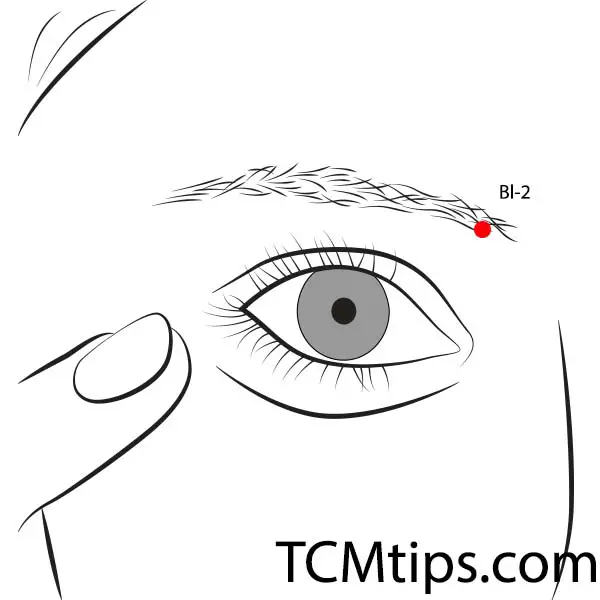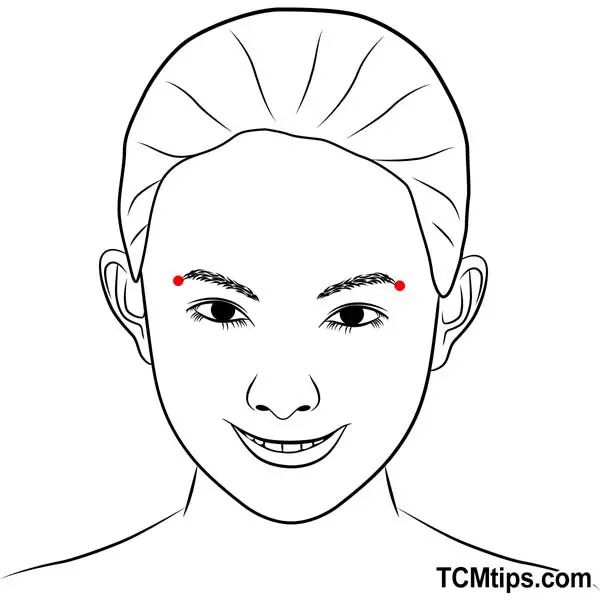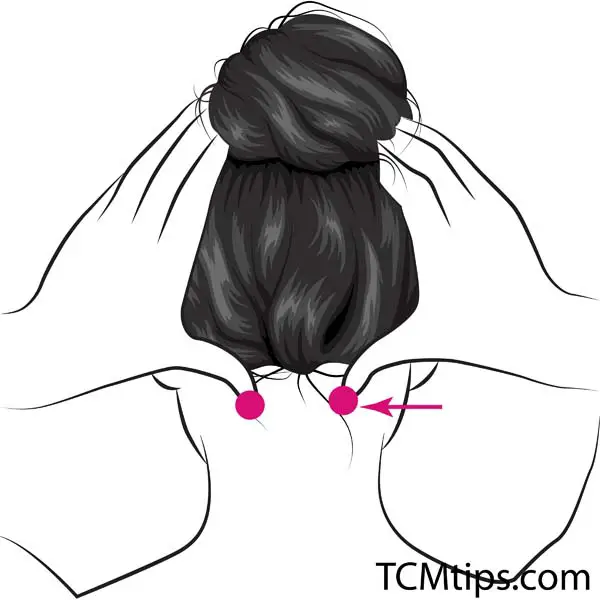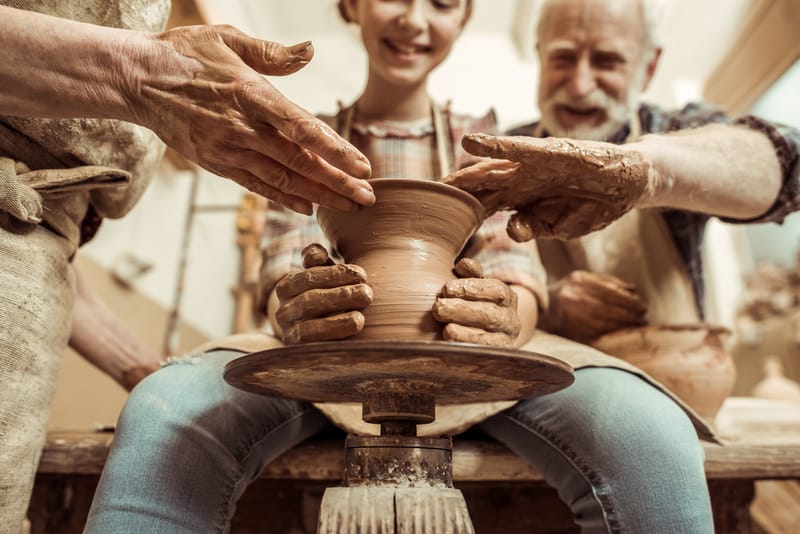Eye pain isn’t considered a serious issue as long as it is superficial and doesn’t affect the deep structures of your eyes. Surface eye pain can be caused by many different triggers, all of which can be treated with the acupressure points for eye pain featured in this article as a complementary therapy. In Chinese medicine, the eyes are considered the functional sphere of the Liver organ, explaining why some diseases of the Liver become manifest in the eyes. Acupressure for eye strain focuses on promoting circulation of Liver Qi and nourishing the liver.
What Causes Eye Pain?
Allergies, foreign objects, infection, and pressure are all examples of things that can cause pain in the eyes. Besides these, some health conditions such as migraine and Covid can cause light sensitivity and pain in the eyes. Since the causes are many, it’s extremely important to observe well what is causing this symptom and to make sure that the pain isn’t a sign of a more severe condition.
In traditional Chinese medicine, the Liver is considered to be closely related to the yes. This concept is different from the liver in Western medicine. The Liver in Chinese medicine refers to an organ that stores blood and its function can be described as that of a control tower. If it slows down, the blood will stagnate. The good condition of the muscles, tendons, and ligaments is also related to Liver health in TCM. Considering this, the function of the Liver is responsible not only for the health of the eyes but also for the good condition of the eyelids and muscles that surrounds it.
Does Acupuncture Help With Eye Pain?

Acupuncture, with its many therapeutic principles, is a great treatment for pain in general, including for pain in the eyes. As far as scientific research is concerned, pressure points for eye pain as well as pressure points to relieve eye strain which has been traditionally utilized in China and elsewhere, are shown to have healing effects on the anatomical and physiological structures in the eyes.
Although scientific data on the effectiveness of acupressure in the treatment of eye disorders are still not evolved enough, some interesting studies are well worth considering. An animal study carried out in laboratory mice has found that acupressure for eye pain applied on the foot of the mice increased blood circulation flow in the eyes. This same study found that no blood flow changes occurred when acupuncture was done at random points on the mice’s backs.
In the traditional Chinese medicine context, symptoms felt in the eyes can be related to blockages in the Shaoyang, Taiyang, Jueyin, and Yangming meridians. Eye pain that is related to Qi stagnation in the meridians is less severe and not considered dangerous. The acupressure points to reduce eye pressure and pain are usually related to those meridians since their course involves the eye area.
Where Are The Pressure Points For Eye Pain?
Acupoint: Bl-2 (Other Names: Urinary Bladder-2/Zan Zhu/Gathered Bamboo)

This point is located above the medial canthus of the eye, at the junction of the eyebrow, near its medial extremity.
Bl-2 is useful when there is pain behind the eyes along with migraine. Apply acupressure for eye disorders in Bl-2 for the following symptoms:
- External pathogenic factors.
- Redness and itching of the eyes (conjunctivitis), rhinitis, and sneezing.
- Headache, sinusitis, and facial paralysis from Wind’s attack on the head.
- Liver syndromes that affect the eyes.
You can use your middle finger to gently massage this point, applying a circular motion for about three minutes on both sides. This acupoint is used in acupuncture for hay fever.
Acupoint: Bl-9 (Other Names: Urinary Bladder-9/Yu Zhen/Jade Pillow)


Find this acupoint at 1.3 cun lateral to GV-17 (located above the occipital protuberance).
- Bl-9 is among the acupressure points for eye disorders that can treat the following:
- Occipital headache, stiffness, and pain in the cervical area due to Wind attack.
- Cold and aversion to Wind in the head and cervical region.
- Disorders of the nose and eyes and dementia.
- It also calms the pain in the eyes.
- Treats myopia, dizziness, headache, hyposmia, hyperhidrosis, encephaloma, eye pain, and nasal obstruction.
Gently press with your middle finger to stimulate. Do not press hard. Bl-9 is also used in glaucoma acupuncture.
Acupoint: TE-23 (Other Names: Triple Energizer-23/Si Zhu Kong/Silken Bamboo Hollow)

TE-23 can be located in the depression located on the supraorbital rim at the lateral extremity of the eyebrow.
This is an acupressure point for dry eyes as well. It’s been traditionally utilized for headache, dizziness, vertigo, conjunctivitis, optic nerve atrophy, nervous tics in the eyelids, facial paralysis, infantile convulsions, and Wind affecting the eyes and face. TE-23 eliminates Wind, calms pain, and has beneficial effects on the eyes.
Massage TE-23 using your middle and index fingers, and apply circular motion at this point for about three minutes on both sides. Find how to use TE-23 in acupressure for better vision.
Acupoint: EM-3 (Other Names: Yu Yao)

EM-3 is found in the center of the eyebrow. When looking straight ahead, this point is located directly above of the pupil.
It is usually used for conjunctivitis, eye pain, blurred vision, tic of the eyelids, ptosis, facial paralysis, pain in the supra-orbital nerve, floaters, and sinusitis. EM-3 is also among the pressure points to stop eye twitching since it disperses Heat, relaxes the tendons and sinews, and removes blockages from the channel.
You can use your middle finger to gently massage this point, applying a circular motion for about three minutes on both sides. You can also use EM-3 in acupuncture for puffy eyes.
Acupoint: GB-20 (Other Names: Gallbladder-20/Feng Chi/Wind Pool)

GB-20 is located inferior to the occipital, in the depression between the insertions of the muscle sternocleidomastoid and trapezius muscle.
Besides using as one of the acupressure points for double vision, GB-20 has the following benefits:
- It eliminates Wind and has beneficial effects on the head and eyes.
- Beneficial effects on the sense organs.
- Stimulates the circulation of the meridian and relieves pain.
- Treats Liver Yang ascent to the eyes as well as eye disorders due to Liver Fire or Liver deficiency.
Apply firm pressure at this point for about three seconds, releasing it intermittently. Do this for three minutes on both sides. GB-23 is among the acupressure points for cataracts.
Acupoint: Bl-18 (Other Names: Urinary Bladder-18/Gan Shu/Liver Transporter)

Find Bl-18 1.5 cun lateral to the lower border of the spinous process of the ninth thoracic vertebra (T9).
Bl-18 stimulates the circulation of Liver Qi and has the following benefits:
- Helps Qi circulation in all the inner organs.
- Regulates and nourishes the blood of the Liver.
- Refreshes Fire and removes Damp Heat, and for this reason, Bl-18 is one of the acupressure points for an eye infection that manifests with swelling in the eyes.
- Has beneficial effects on the eyes and tendons.
- Treats Qi obstruction in any area of the body, especially Liver QI.
- Treats blood extravasation (epistaxis, hematemesis) caused by the pathological ascent of Yang.
- Treats Liver blood or Yin deficiency.
This point can be stimulated by applying a firm pressure using both thumbs for about ten seconds. Then, you can repeat it three to five times. Bl-18 is one of the acupressure points for eye floaters.
What Helps A Headache And Eye Pain?
The same acupressure points for eye pain can also help relieve some types of headaches, mainly those caused by blockages in the flow of vital energy in the meridians whose course surrounds the eye area. In TCM, headaches are classified according to the area of the head where it is felt.
- Temporal headaches are related to the Shaoyang meridian
- Occipital headaches are related to the Taiyang meridian
- Frontal headaches are related to the Yangming meridian
- Vertex headaches are related to the Jueyin meridian
Since the meridians are bilateral, the same acupressure points for pain behind the right eye are utilized for the left as well. A commonly therapeutic principle applied in classical Chinese medicine is acupuncture on the opposite side of the painful area. For example, if the pain is felt in the right eye, it is common to do acupuncture on the left eye in order to avoid puncturing an already troubled zone.
Takeaways
Acupressure points for eye pain can treat different health conditions affecting the eyes. For example, in TCM, the eyes are the functional sphere of the Liver. When the Liver isn’t well nourished, and with enough amount of good quality blood, the eyes can suffer from a reduction of vision, dryness, and even cataract in extreme cases. Among the symptoms that acupressure points for eye pain can treat is pressure behind the eye due to migraine, eye strain, dry eyes, double vision, eye twitching, eye bags, and eye inflammation, to name a few.
- Bl-2 treats pain and pressure behind the eyes in cases of migraine.
- Bl-9 improves the function of the eyes and calms the pain in the course of the Bladder meridian.
- TE-23 is an acupressure point for under-eye inflammation that treats headache, conjunctivitis, and optic nerve conditions.
- EM-3 treats eye pain, blurred vision, tic of the eyelids and is used in acupuncture for eye bags.
- GB-20 is the command point to eliminate Wind in the head and eyes. For this reason, it is one of the acupressure points for watery eyes.
- Bl-18 directly affects the Liver, treating Qi stagnation, nourishing Liver blood, and treating Yang and Fire ascent to the eyes.

Try our Anti-Aging Gua Sha Tool designed to bring out your skin’s natural glow.
Best Gua Sha Product- Anti-Aging: The tool is designed to target 11 specific aging signs such as wrinkles and sagging skin. By following the 7-step routine, users can improve skin firmness and reduce fine lines naturally.
- Enhances Skincare Routine: It works effectively with serums and lotions, boosting absorption and efficacy of skincare products.
- Visible Skin Improvement: Users can expect a smoother complexion, reduced puffiness, and a more youthful appearance.
 P. Sze
P. Sze 

















